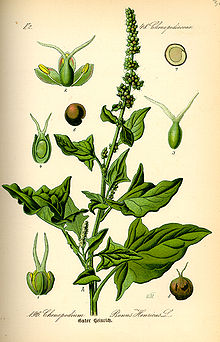- Chenopodium bonus-henricus
-
Good King Henry 
Scientific classification Kingdom: Plantae (unranked): Angiosperms (unranked): Eudicots (unranked): Core eudicots Order: Caryophyllales Family: Amaranthaceae Genus: Chenopodium Species: C. bonus-henricus Binomial name Chenopodium bonus-henricus
L.Good King Henry (Chenopodium bonus-henricus), also called Poor-man's Asparagus, Perennial Goosefoot, Lincolnshire Spinach or Markery[1]is a species of goosefoot which is native to much of central and southern Europe.
Good King Henry has been grown as a vegetable in cottage gardens for hundreds of years, although this dual-purpose vegetable is now rarely grown and the species is more often considered a weed.
Contents
Appearance
It is an annual or perennial plant growing up to 400–800 mm tall. The leaves are 50-100 mm long and broad, triangular to diamond-shaped, with a pair of broad pointed lobes near the base, with a slightly waxy, succulent texture. The flowers are produced in a tall, nearly leafless spike 100–300 mm long; each flower is very small (3–5 mm diameter), green, with five sepals. The seeds are reddish-green, 2–3 mm diameter.
Cultivation and uses
It should be planted in a fertile, sunny spot which is free from perennial weeds. Seeds should be sown in April in drills 1 cm deep and 50 cm apart. The seedlings should then be thinned to 10–20 cm. The plants should be regularly weeded and well watered. Typically, very little is produced in the first season. Good King Henry does not respond well to transplantation.
The foliage can be cut in autumn, and a mulch, such as leaf mould or well-rotted compost applied to the plot.
Culinary uses
Cropping can begin in spring. Some of the new shoots can be cut as they appear (usually from mid spring to early summer) and cooked like asparagus. All cutting should then cease so that shoots are allowed to develop. The succulent triangular leaves may be harvested a few at a time until the end of August and cooked like spinach.
References
- ^ Great British Bites: Lincolnshire spinach Times Online, 13 May 2008
Categories:- Chenopodium
- Flora of the Mediterranean
- Flora of Europe
- Leaf vegetables
- Stem vegetables
Wikimedia Foundation. 2010.
